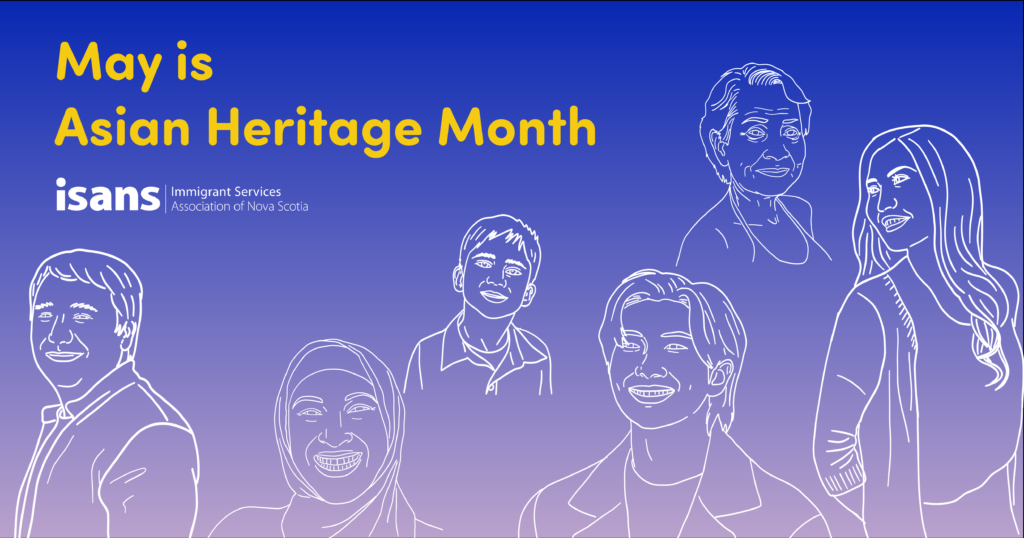Asian Heritage Month: Breaking Stereotypes and Understanding Misrepresentations in the Media

What is Asian Heritage Month, and Why is it Important to Recognize?
Did you know that about 17.7% of the Canadian population is made up of Asians? According to Statistics Canada’s 2016 census, Asian people represent 3.8% of our community here in Nova Scotia. Immigrants of Asian descent come from many different regions such as East, Southern, Western, Central, and Southeast Asia, bringing with them their rich cultural heritage.
Asian Heritage Month in Canada is an opportunity to recognize and celebrate the contributions of Asian Canadians across our country. This month-long celebration brings together people from all backgrounds and cultures to honour the history, culture, and achievements of Asian Canadians. This month serves as an avenue for Canadians to learn more about the diverse history of Asian Canadians, their struggles, and their successes. By celebrating and learning, we can acknowledge the importance of recognizing our past while also looking forward to a better future for all Canadians.

Standing up for Justice
While there is so much joy in being Asian, there are some unfortunate realities Asian people experience living as a minority group in a White-dominant society.
In Asian Heritage Month over the last few years, we addressed our concerns with stories of rising anti-Asian racism during COVID-19 in both the United States and Canada. In 2020, there were 1,150 reported incidents of anti-Asian racism across Canada on covidracism.ca and elimin8hate.org. Between January to December 2021, there were 943 reported incidents. In response to this, we have created resources on our website about how to identify and deal with violence based on discrimination, how to be an ally and how to intervene as a bystander.
It takes collective actions to fight systemic issues, but educating ourselves and the people around us is an important first step we can all take to make our community more welcoming.
Examining Stereotypes and Misrepresentations of Asians in the Media
One systemic issue in our society that we’d like to call attention to is the way the media stereotypes and misrepresents Asians, which causes great harm to people of Asian descent.
How You See Me: Asian describes some of the lifelong experiences Asians face when it comes to stereotypes
Stereotypes can form when we categorize people in groups without considering that one person or characteristic doesn’t represent people in the rest of the group. People from underrepresented groups can face harmful, generalized beliefs in their daily interactions, including when meeting someone new, or even while talking to a person very close to them. For Asians, these can sound like: “I didn’t think Asians could be funny. I always thought they were serious,” or, “But people like Asians. They are the smart and well-mannered ones.”
For many people, these stereotypes form based on their experience watching how Asians are portrayed in popular media. Unfortunately, in Western media, there aren’t enough representations to show how Asians are just people, with as many idiosyncrasies and complexities as anyone else. Instead, Asians in Western media are falsely characterized in narrow and oppressive ways, such as that they are smart, docile, or weak. To make matters worse, Hollywood used to hire Caucasian actors to play Asian characters, using eye prosthetics and makeup to make them appear “more Asian,” such as Katharine Hepburn as Jade Tan in Dragon Seed.
According to the University of Southern California, across 1,300 top-grossing films from 2007 to 2019, 3.4% had an American Pacific Islander (API) lead/co-lead, with only six movies featuring an API woman in a lead/co-lead role. Across 200 top-grossing films from 2018 and 2019, 74.7% of tertiary or minor API characters spoke five lines or less in films. Of these small percentages of API representations, the characters range from invisible to fully human, falling into the categories of a foreigner, stereotyped, tokenized, and sidekicks.
In Jamie Jung’s Ted Talk, she speaks about the absence and misrepresentations of Asians in media that have contributed to her struggles with self-identity and dreams.
Whether through the absence of Asian characters or through stereotypical depictions, media has a huge influence on how we view different races and cultures, which is why it is so important to examine and be critical of the information we perceive through our favourite TV shows and films.
How Can We Celebrate and Promote Positive Representation and Diversity?
In recent years, many people celebrated the South Korean film Parasite, which won an Academy Award for Best Picture. This was a big deal – it was the first non-English film to win Best Picture. And just this year, Everything, Everywhere, All at Once won seven Academy Awards with Asian leads portraying Asian characters with immigrant stories. We’re also seeing even more Asian leads in Netflix shows like Squid Game, To All the Boys I’ve Loved Before, Never Have I Ever, and Beef.
It is our hope that, soon, we no longer hear the word “first” when describing Asian directors, actors, and films. With more accurate representations of Asians, by Asians, we hope that there are more creative opportunities for us to share our stories and diverse perspectives. We don’t want these opportunities to be limited to media or the entertainment industry, either; we also want to see them in politics, our workplaces, leadership positions, and sports.
For now, we’re hopeful these achievements act as a gateway to greater cultural exchange, recognition, and inclusion of the many different people that make our community a more vibrant and welcoming place for all.
References:
Fight COVID Racism, covidracism.ca. Accessed 5 May 2023.
Dr. Nancy Wang Yuen, Dr. Stacy L. Smith, Dr. Katherine Pieper, Marc Choueiti, Kevin Yao & Dana Dinh. “The Prevalence and Portrayal of Asian and Pacific Islanders across 1,300 Popular Films.” https://assets.uscannenberg.org/docs/aii_aapi-representation-across-films-2021-05-18.pdf. Accessed 5 May 2023.
“Asian Heritage Month 2022... by the numbers.” Statistics Canada, 22 May 2022, https://www.statcan.gc.ca/en/dai/smr08/2022/smr08_262. Accessed 5 May 2023